Photos: Kip Miller
It has been our good fortune to know and love Chios. Back in 1978 when relations between Greece and Turkey were at an especially low point, we were trying to reach Izmir from its neighboring island, Lesbos, but ship crossings had been cut off. "Take the evening boat to Chios," the harbormaster suggested. "From there you will be able to cross to Cesme in the morning." As we disembarked in Chios, I remember staring at a line of passengers searching for accommodations for the night. A curly-haired boy was an exact double for our three-year old son at home with our nanny in Philadelphia. I remember gasping for a brief moment, thinking that somehow Jeremy had arrived in Greece. We took a no-frills room at the harbor, followed by an early breakfast of foamy Greek coffee and bougatsa pastries. "We have to return," I declared to my husband as I looked back from our ferry at a crowd of Chiotes immersed in their morning rituals.
Seven years later, traveling with Jeremy, our daughter Alison and my recently widowed mother, we arrived in Chios--again from Lesbos--just after the August 15 panegyria--also known as the summer Easter--that are celebrated in nearly every locale in Greece. It was the country's busiest time of year, when hordes of Greeks return to their native villages to mark this beloved holiday. "What were we thinking?" I complained to my husband. "We've dared to come to Chios without reservations!" At the tourist police they directed us to a lonely hotel on the edge of town. That night, the famous Chios wind was especially fierce and the shutters outside our rooms banged with vengeance until dawn. Miraculously, the modern Chandris Hotel at the port had a few vacancies the next morning. Secure in our accommodations, we set out to explore the island, taking buses to several destinations. A couple of days later, as we were exploring the town, a familiar voice rang out over a crowd of shoppers: "I don't believe it!" We were amazed to spot Niko and his sister Eleni, close friends from America whom we had known for many years. I was aware that Chios was their island, but did not expect that they would be visiting at this time. What serendipity! We all gathered the next evening for a family reunion at their home in Kallimasia, complete with a delicious feast prepared by their loving parents.
Chios welcomed
us again in 1998, this time arriving from Cesme after a two-week sojourn
in Turkey, accompanied by our friends Elinor, Mary and Bill. We had been
instructed by Niko to call his mother, directly since he would not be
in Greece at that time. A taxi whisked us to Kallimasia in less than 15
minutes. Despina showered us with unstinting hospitality, and after Bill
and Mary returned to Athens, we rented a car and took her with us on sightseeing
excursions to Pyrgi and Mesta, to visit friends in Thimiana, to purchase
embroidered linens in Kallimasia's handicrafts cooperative, and to dine
at her favorite tavernas.
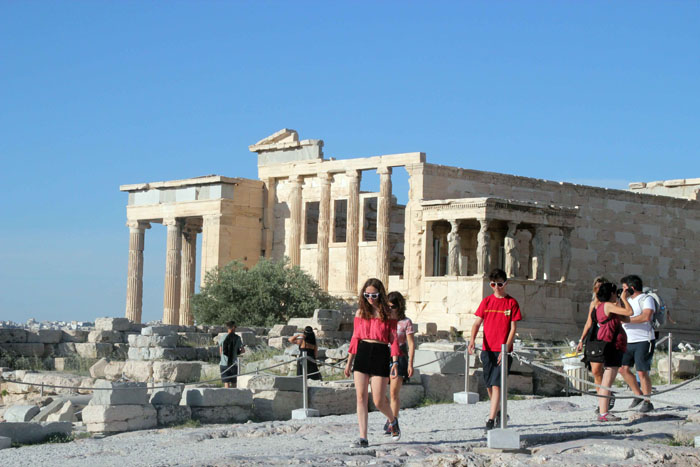
On a breathtakingly clear day, Emma and Aidan encircle the ancient temples of the Acropolis with obvious excitement.
Fast forward to 2018. This journey marks our 29th trip to Greece, a country we have loved for decades. But the trip is extra special because Alison, our son-in-law Ray and grandchildren Emma and Aidan are coming along. To see Greece through their eyes will be all the more meaningful. In 2011 on our last visit, Greece was undergoing a severe financial downturn plagued with high unemployment, decimated pensions, homelessness and angry protests. On the long ride into Athens from the airport, our taxi driver shares his view of the current situation. "Do you think the economy is beginning to turn around?" I ask. "Perhaps, but we still have problems," he sighs. "But one thing is certain, Athens is experiencing a huge increase in tourism," he concedes as he deposits us in front of the Airotel Parthenon, steps away from Plaka. "We are solidly booked all summer!" the man at the desk boasts as we check in. Wasting no time, we head out to a popular taverna, Café Byzantino, to commemorate our arrival. I am tickled to find Plaka swarming with tourists. Nearby, the entire Acropolis area and surrounding attractions are also jammed. Just as I had hoped, our family is visibly excited, and when we scale the Acropolis the next afternoon, Aidan and Emma are practically squealing as they encircle the ancient temples, doubly impressed by panoramic views of Athens on what is an unusually clear day. We pack in a lot of sightseeing into our two days, including a visit to the world-class Acropolis museum, shopping in the flea market area of Monastiraki, and even a performance of the Dora Stratou Folk Dance Theater.
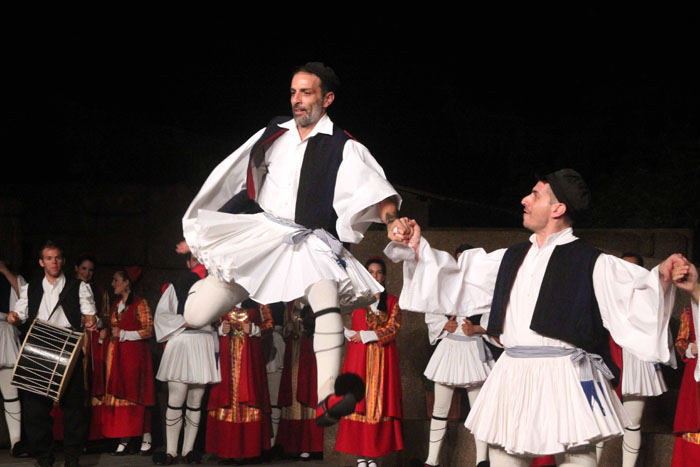
Front row center seats at the Dora Stratou Dance Theater allow us to zero in on a bravura leap in its signature suite.
I have forgotten how quick island flights are. We arrive in Samos on a cloudless afternoon and head directly to our hotel, the Glicorisa, a well-maintained resort property only a five-minute taxi ride beyond the island's main tourist destination, Pythagoreion, namesake of the ancient mathematician. The hotel's sprawling grounds are lavishly landscaped with flowering shrubs and fruit trees. A curving staircase descends to a private bay and beach area lapped by a shallow, limpid sea less than kilometer from the Turkish mainland. "You can actually swim over to Turkey," says the cab driver as we gape at the spectacular setting. Samos is a perfect respite from the urban bustle of Athens, and we soak in the sun and the refreshing sea, savor the cooking at its beachside restaurant, and even make a couple of excursions to Pythagoreion's half-moon harbor jammed with tavernas and surprisingly fashionable shops. We are the only Americans at the Glicorisa, the majority of its patrons hailing from Germany and Switzerland. One group of women have been coming every summer for over twenty years. They are as fascinated with us and our love of Greece as we are with them, and we break into several animated discussions. The days fly by and soon it is time to head to Chios, our main destination, where we will have a week to reunite with Niko and his family.
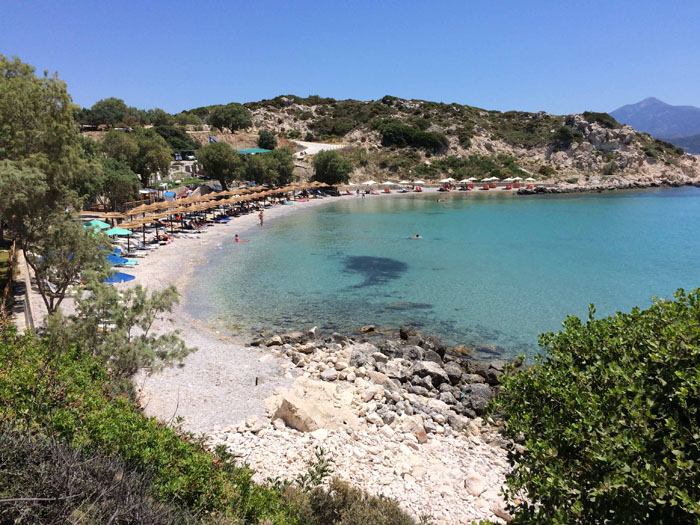
The Glicorisa Beach Hotel in Samos is a resort property within sight of the Turkish mainland. Landscaped gardens descend to a private bay and beach area lapped by a shallow, limpid sea.
Boat crossings to Chios are infrequent off-season. Fortunately, there
is air service available, and we arrive a day ahead of schedule, marveling
that our flight lasts only 35 minutes. Just at the edge of Chios town
(Chora), the Greek Castle Hotel is a boutique property built around what
was once an old pasta factory. We survey the premises, delighted that
our rooms have balconies viewing the sea. An old water wheel irrigates
gardens dotted with pines and citrus. Encircling the entire property are
Genoese-inspired stone walls. The hotel is known for its restaurant, Pyrgos,
an airy space retaining its original pine floors and massive beams and
leading to an enormous pool with bar area. Again, we seem to be only Americans
here, the majority of the guests being Greek and German. I am astounded
to hear Turkish spoken by several families. Near the desk a wall rack
is stacked with guide books on Chios in Turkish! "Good," I whisper
to my husband, "this is something new. The Turks are helping to revive
the local economy!"
In early evening Niko makes two round trips to bring all of six of us out to Kallimasia for a family welcome dinner. As he turns inland from the beach areas, the traffic dissipates and Chios begins to reveal its charms. I can hear goat bells tinkling in faraway hills obscured by low clouds. The fresh aroma of citrus hangs in the air as he winds past the walled gardens of Kambos toward his village. Distinguished by elegant three-story mansions built of reddish stones from nearby Thimiana, Kambos became the domain of the Genoese aristocracy when they discovered that the local soil was perfect for citrus farming. Their orchards were so fecund that soon there was enough yield to export to other cities in Europe. In time, some wealthy Greek ship owners and merchants also built country retreats in Kambos. Latticed iron gates and high walls shielded these properties from intruders. Inside, elaborate gardens were watered by a maganos, a donkey-driven water wheel that enabled water to circulate throughout an entire garden. Several estates in Kambos have been converted to exclusive, luxury hotels. "We are just passing the Argentikon," says Niko. "Have a look! It was built in the 16th century and it's considered one of the best small hotels in the world!"
Kalimassia
is one of 24 mastic communities that dot Southern Chios. During the Middle
Ages, it became one of the largest producers of the coveted resin, but
was virtually destroyed by the great earthquake that leveled much of the
island in 1881. We pull up next to Niko's house and ascend the stairs
to an airy veranda and into the welcoming arms of Despina, now in her
mid-nineties. Wonderful aromas emanate from the kitchen. Eleni and her
husband Harry have been visiting for several weeks and together with Niko
have been cooking all afternoon. I notice that the house has been lovingly
remodeled since Niko moved back to Chios. Handsome vintage furniture,
majolica ceramics and copper accessories honor his Chian heritage, and
I am reminded of all the times we used to go antiquing in Los Angeles.
Among the huge spread set on the table are Eleni's delectable stuffed
tomatoes, and I make a mental note to make them more often at home. A
long-time friend, Dimitris Melachrinoudis, is one of the dinner guests.
During his many years as a sea captain, he became fluent in English. He
is he a proud founding member of the Folklore Museum of Kallimassia, having
also written a comprehensive history of the village. "I would like
to invite all of you on a private tour of our collection after dinner,"
Dimitri announces with a twinkle in his eye.

Captain Dimitris Melachrinoudis, one of the founders of Kallimasia's Folk Museum,
demonstrates vintage tools in a charming recreation of a-turn-of the-century shoemaker's shop.
Located on the lower floor of the junior high school (gymnasio), the museum
has amassed one of the largest collections of domestic artifacts in Greece.
It is a journey back in time to the traditional occupations and pastimes
that typified village life: the tinker, the blacksmith and the candle
maker, the ouzo distillery, the weaver and the shoemaker, the Karaghiozis
shadow puppet theater, the threshing floor and the beehives. Dimitri pauses
by the stone wheel of an olive press, turns the crank of an old coffee
grinder in the cafenion, and then poses by a vignette crammed with vintage
barber shop accoutrements. Every object on display provides a unique glimpse
of life at the turn of the century. "I hope all of you enjoyed our
museum," he concludes with obvious pride. Please come and see us
again!" "Now I must hurry home," he mutters as he drops
me back at Niko's house, eyes crinkling in a smile. "Lemonia, my
dear wife, requires some attention!"
Distances in Chios necessitate wheels, so we select a Nissan SUV with enough seating for seven. "It's perfect," says Ray as he encircles the vehicle. Wasting no time, we pick up Niko by the school and head out to Pyrgi and Mesta, the two most visited mastic villages in Chios. These well-preserved towns came into their heyday between the 14th and 16th centuries, earning special privileges from the Genoese and Turks because of their valuable crop. Southern Chios is the only place in the world where mastic trees flourish. A relative of the pistachio tree, the squat pistachia lenticus sheds droplets of clear resin that were first recognized by Hippocrates for their medicinal properties -- from aiding digestion and curing ulcers to freshening breath, whitening teeth, and treating snake bites. Modern pharmacology has discovered that these droplets are also loaded with antioxidants and antibiotic properties and can even lower blood pressure and cholesterol. Mastiha is added to liqueurs and spoon sweets, to flavor Easter bread and, of course, to make chewing gum and candy. It is rumored that the great Stradivarius added a drop of mastiha to his proprietary violin resin, convinced that it improved the sound outcome. For the Ottomans who controlled Chios for several centuries, it was an indispensable commodity, especially popular in the Sultan's harem where scores of masticating concubines were kept fresh and ready should they be selected for a conjugal visit. "Mastiha is an acquired taste," I explain to Emma and Aidan. "At first it feels strange, as if an entire pine forest has invaded your mouth, but ultimately, it is quite refreshing!"
We make a
preliminary stop in Armolia, a modest village famed for a long tradition
of ceramic arts sustained by a nearby lake that provides unlimited clay.
For generations, talented local craftsmen have been producing bowls, plates
and pitchers painted with charming bird, flower and fish motifs. On a
hill nearby, the Apolichna is an enormous crumbling castle built by the
Genoese in 1440. Some of its double walls and defensive towers can be
explored, but it's a steep hike. I gaze at the countryside, a spectacular,
rolling landscape carpeted with wild arbutus, gnarled lentisks, small
oaks and strawberry trees. We browse at several of Armolia's shops, selecting
a few gifts, and then continue to Pyrgi, the capital of the mastic communities.

Unique in all of Greece, Pyrgi's facades and balconies are embellished with a decorative technique introduced by the Genoese centuries earlier.
Unique among Southern Chios's villages, Pyrgi is a large settlement built around a central plateia, its narrow, winding streets overhung with balconies that nearly touch each other. What makes the town so exceptional is the local tradition of "xysta," an eye candy decorative style introduced by the Genoese many centuries earlier. "The Italians call it sgraffito," explains Niko. "The walls are white-washed and then scraped with a special fork to create geometiric patterns such as circles, rectangles, diamonds, crescents and stars, revealing the original gray-black of the stone. There is nothing like it anywhere else in Greece." We stroll toward the plateia where several cafeneia are popular hangouts. On its northeast side, the tiny Byzantine church of Agioi Apostoloi is known for its intricate brickwork and magnificent frescoes by the Cretan painter Antonius Kynegos. Inside the dim interior we discover scenes of the Last Judgment and the Miracles of the Apostles, inspired by stories of Paul's passage through Chios on his way to preach at Miletus. An inscription on the northwest pilaster says the church was erected in 1546 by the priest-monk Symeon.
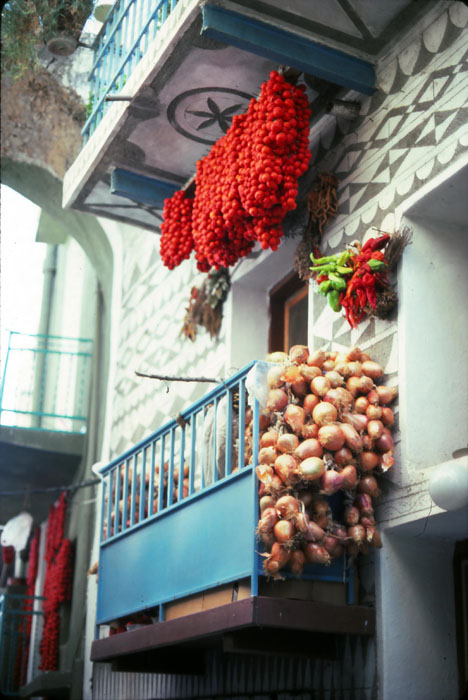
Pyrgi's small tomatoes are harvested from mid to late summer and hung from balconies and facades,
often lasting through the following winter. Photo from our 1985 trip to Chios.
Pyrgi is also famous for its tomatoes, which are harvested from mid to
late summer, strung up in braids and hung from balconies and facades,
often lasting through the following winter. On a previous visit to Pyrgi,
I remember carrying on a discussion with a local gria (old lady) who was
stringing them up, and another who was trimming a mountain of fasolia
(green beans) for a large family dinner. "The tomatoes remain raw
in the center," they explained, "and do not spoil." The
red of the tomatoes adds punch to the exteriors of the houses, making
Pyrgi one of the most photographed villages in all of Greece. We stop
to browse in a shop displaying a large assortment of mastic products,
including special soaps and body lotions, T-shirts emblazoned with xysta
designs, and small facsimiles of Pyrgi facades suitable for hanging. Emma
finds the perfect shirt in black and white. "I am going to wear it
right now!" she insists with satisfied grin.
Medieval
Mesta is completely contained within a thick circular wall, resembling
a giant turtle with its head pulled in, with only the hard shell remaining.
Like its sister villages, Mesta was under the constant threat of pirates
who coveted its cache of mastic. To thwart these attacks, the town built
a solid stone exterior with no visible entrances, just a continuous curvilinear
wall that enclosed all the houses and a steep central tower where people
could congregate in the event of a siege, having escaped their homes through
secret rooftop doors. Luckily Niko knows exactly where to enter Mesta,
and we find ourselves wandering through labyrinthine lanes brightened
by vines and flowers. Here and there vaulted passageways hide tiny shops
manned by villagers sitting on their stoops, all engrossed in their routines,
completely oblivious to our presence. "You can actually visualize
what life was like here!" says my husband, impressed by the time
warp ambiance.
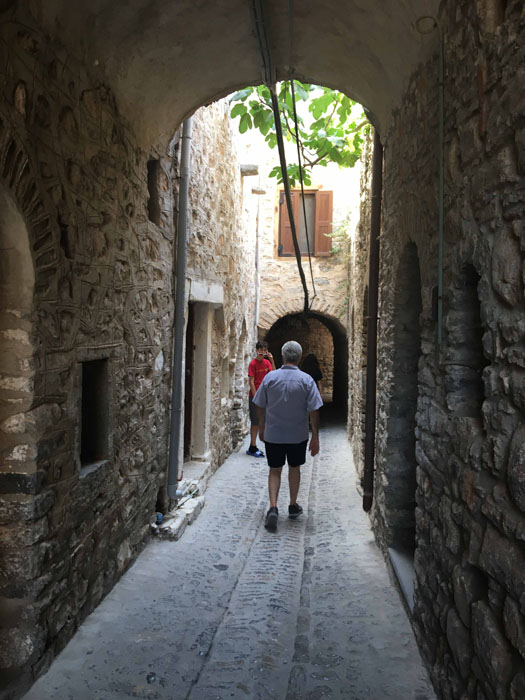
Niko leads us through medieval Mesta's labyrinthine lanes,
connected here and there by overhead passageways.
Mesta's ornate central church, Megalos Taxiarchis, overlooks the main
square. It is dedicated to the Archangels Michael and Gabriel and built
over the site of the town's demolished defensive tower. We are awed by
its huge size. "This church took a full ten years to build and it's
the largest in Chios," explains Niko. We approach the narthex area
where bits of the pre-existing tower can still be seen. The exquisite
altar is hand-carved from a single piece of wood. "Have a look at
our chancel screen," says the church attendant. "It dates from
1895, but the wonderful icons of the two Archangels come from the original,
much older church." Outside, a pebbled courtyard descends to Mesta's
central square, known for its cafes and an excellent taverna, O Mesaionas,
owned by Despina Bournia, one of Mesta's most ardent promoters. "You
have to try the tomato keftedes," insists Niko. "It's their
specialty." We can barely finish the huge spread on the table. Our
waitress suggests we sample the local spirit, souma, made from a distillation
of figs. "The figs are collected in August and put on rooftops to
dry in the sun. After fermenting in barrels mixed with water and yeast,
they are later boiled in a distillery," explains Niko. Apparently
souma is even more potent than raki. "In Chios we always drink it
at weddings, festivals and other important occasions," he chuckles.
Not far from Pyrgi, the recently built Mastic Museum showcases the entire cultivation and production cycle of the resin. The museum is listed in UNESCO'S roster of sites that demonstrate "Intangible Cultural Heritage of Humanity" and one could easily spend an entire day here absorbing all the production details. However, we are most interested in its open-air area where one can see the trees up close during their cultivation phase. "The museum has the full support of the Chios Gum Mastic Growers Association," an English-speaking attendant explains. Rows of neatly pruned trees have white powdered "tablecloths" spread under their branches to collect dripping globules of mastic. Shallow cuts have also been made in the trunk of each tree to stimulate the "weeping." "Every phase of the entire process is done by hand," the attendant emphasizes. "What a labor-intensive occupation!" notes Alison.
Chios is equally famous for its many beaches. Niko recommends the dramatic Mavra Voglia, created by a volcanic explosion eons ago. The beach is completely covered with shiny black and gray pebbles which also line its ocean floor, turning the water a rich dark blue. Massive boulders bookend the area which is serviced by popular fish tavernas, and one can be happily entertained here for hours. "You should also visit Komi and Karfas, two popular family beaches," suggests Niko. "They have lots of services and fine sand, and both are within a short drive from Chora. The kids decide to return to the hotel, but we linger in Kallimasia, anxious to experience the Stefanidis nightly "salon on the veranda." In mid evening, neighbors, friends and relatives begin to drop by, sometimes unannounced, to partake in hours of lively conversation and, of course, refreshments. These Chiotes are not glued to their televisions like we Americans. They much prefer the non-stop repartee and joy of face to face visits. Some of the guests are regular fixtures, such as Stamatis, whom I remember meeting in Los Angeles and who gives me a hefty sack of his home-grown oregano on our last night. Another friend, Pantelis, brings a packet of dried figs from his farm, the very ones that are used to make souma. "I will have more dropped off at your hotel," he promises when I tell him how much Ray loves figs. The generosity of these friends, and Greeks in general, is quite touching, and I remind myself that the tradition of filoxenia (hospitality) was invented in Greece!
While the
kids enjoy a beach day, the two of us explore Chora, once considered the
most elegant maritime community in the Aegean. When independence fever
swept the island in 1822 under the urging of neighboring Samos, the Turks
grew fearful that control of their mastic empire was threatened and proceeded
to commit the most gruesome massacre in modern European history. They
decimated Chora, burning buildings and slaughtering at every turn, then
continued inland to villages and monasteries where many islanders had
fled. When it was all over, some 25,000 Greeks had been killed and an
equal number enslaved. Others managed to escape to nearby islands. Ultimately,
only 2,000 Greeks out of a total population of 117,000 remained in Chios,
most of them from mastic villages that had been spared so they could continue
collecting the resin. Europe was outraged by the atrocities, a level of
barbarism never witnessed before. The French were especially horrified,
and the great painter Delacroix memorialized the carnage in his poignant
canvas, "The Massacre at Chios." Completed in 1824, it still
hangs in the Louvre in Paris. A life-size copy of the painting is also
on display in the Chios Byzantine Museum, housed in the old Ottoman mosque,
Mecidiye Camii in Vounakiou Square.
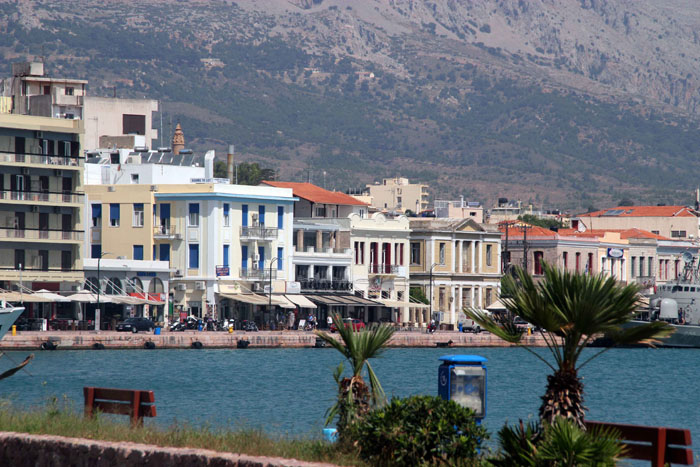
In earlier centuries, the Chian capital (Chora) was the most elegant maritime community in the Aegean. While traces of its tragic past remain, today it is a reborn, lively town, its busy waterfront packed with bars, tavernas and sweet shops.
We wind through Chora's streets, past the main cathedral, stopping next door to view the Argentis folklore collection housed in the neoclassic Korais Library. Nearby, the town's famous Aplotaria, a pedestrian-only shopping street, is abuzz with locals. Many vestiges of Chios's golden era can be found in the port area. On the north end the huge kastro and its ramparts contains the Giustiniani Palace, built by the Genoese. In the middle of town, beautiful municipal gardens surround a bronze statue of Constantine Kanaris, the fearless revolutionary hero who burned the flagship of the Turkish navy and killed its admiral, Kara Ali Pasha, to avenge the Chios massacre. While a few dark shadows of the past still linger in Chora, it is a bustling, upbeat town. The large waterfront area is lined with crowded bars, tavernas and sweet shops such as Candio, operated by George and Eleni Yianiodis. We had stopped there yesterday for a delicious lunch. "Ah, Nikos! Einai kalos anthropos (Niko is a good man!)" George had exclaimed when I told him who had recommended his shop. "Don't tell him, but we are lucky to have him here in Chios! Kales diakopes (have a good vacation)!" He grinned, handing me a large box of his very finest sweets.

During the great massacre of 1822, many Chiotes sought refuge at Nea Moni. Displayed behind glass, their skulls and bones are a poignant reminder of the slaughter that occurred there.
It's a magnificent cloudless morning. We are ascending Mount Provateio in central Chios toward the monastery of Near Moni, dating from the 11th century and a UNESCO World Heritage Site. Ray maneuvers each curve of the road like a seasoned mountain goat, and I am grateful that I am not doing the driving. Hidden away in a remote site amid towering cypresses, the monastery dates from the reign of Emperor Constantine Monomachos. It is considered one of finest Byzantine monuments in the world, especially famous for mosaics that are among the rarest examples of Macedonian Renaissance art found in Greece. According to legend, it was built on its present site after three monks discovered a precious icon of the Virgin Mary hanging on a myrtle tree. The monks told Constantine, then in exile in Lesbos, of a vision that he would soon become Emperor. When he acceded to the throne in 1043, the grateful Emperior began constructing the monastery. The entire complex was completed in 1056 and soon accommodated nearly 800 monks. During the great massacre of 1822, Nea Moni was sacked and looted, and its occupancy steadily declined. "Today there is only one monk left," says Niko. We enter a small chapel where rows of skulls and bones are stacked behind glass, a shocking reminder of what transpired here. The octagonal Catholicon, the main church, is currently undergoing extensive restoration, but we can admire fragments of its glittering mosaics. Amazingly, the famous icon of the Virgin has survived the centuries unscathed, glowing gently in its ornate frame. Another building houses the monastic dining hall, the trapezaria, dominated by an enormous marble table with niches for flatware. "Wow!" says Aidan. "I can almost imagine the monks seated around the table!"
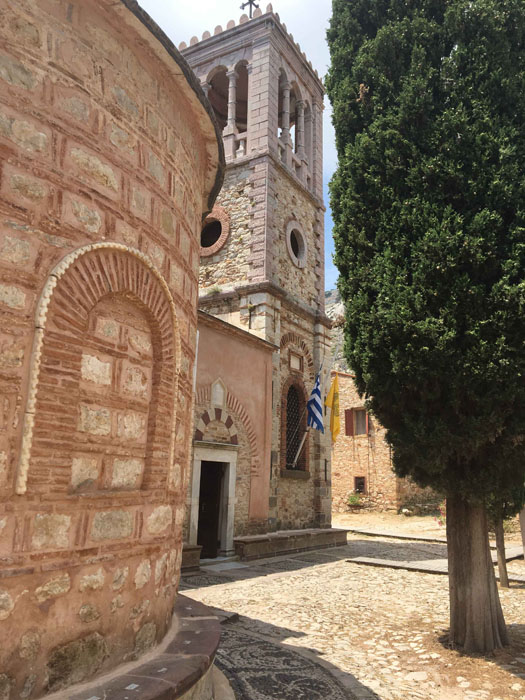
Nea Moni was built by Byzantine Emperor Constantine Monomachos in the 11th century. The monastery houses a trove of exquisite mosaics, the rarest examples of Macedonian Renaissance art in Greece.
Anavatos is an abandoned community known as the Mystras of the Aegean. Clinging dramatically to a precipice, this village of 400 houses served as a last defense during pirate attacks. When the Turks scourged nearby Nea Moni, many of its inhabitants opted to plunge to their death into the ravine below ahead of the enemy's arrival, echoing the heroics of the women and children of Zalongo in Epirus in the battle of 1803. The great earthquake of 1881 dealt a final blow to Anavatos and the village was abandoned. As we climb its steep streets, a gentle breeze blows through the open windows and doorways of the roofless houses, rustling the leaves of olive and pistachio trees. This ghost town is quite popular with visitors, a remarkable vestige of the past now declared a national monument and a protected site. We continue to the 11th century village of Avgonima, only four kilometers from Anavatos. It is a jewel of town, with medieval architecture characterized by tall stone houses, small windows and narrow alleys. It is Niko's birthday, and we stop for lunch at To Asteri, a taverna overlooking the sea below. The owner has many recommendations for us, from crispy kalamaria and fava puree to dolmades, keftedes, a huge Greek salad flecked with local capers, and "the best French fries you have ever tasted!" "What will they come up with for a birthday cake?" I whisper to Alison. Not to worry. Out comes a round platter heaped with loukoumades (fried doughnut balls) surrounding a big mound of their own mastiha ice cream with a candle in its center!
 Atop
a steep precipice, the ghost village of Anavatos is known as the Mystras
of the Aegean. In 1822, its residents plunged to their death ahead of
the advancing Turkish forces.
Atop
a steep precipice, the ghost village of Anavatos is known as the Mystras
of the Aegean. In 1822, its residents plunged to their death ahead of
the advancing Turkish forces.
Time has flown and our week in Chios is quickly drawing to an end. Over the millennia, visitors have come here mostly uninvited. First came Poseidon who seduced a local maiden, who then gave birth to a boy named Chios (snow), giving the island its name. Wave after wave of invaders followed, each group leaving an imprint on the local culture. Yet Chios remains well off the tourist radar, making it all the more endearing. We return to Chora for a last dose of its unique charm and some shopping. An artisanal wood shop displays elegant bowls fashioned of mastic and olive wood. An old-fashioned hat store specializes in fisherman caps with embroidered detailing. But the modern Beneti Bakery is something unexpected, part of a burgeoning food chain with outlets throughout Greece. Sliding glass doors open to an eye-popping array of crusty country loaves, assorted bread sticks, giant wheels of halva, fragrant Greek pastries and prepared sandwiches. "This is the new Greece!" I tell my husband. We continue to the Kastro area to meet up with Niko at Kivotos Tou Kosmou (the Ark of the World), a wonderful non-profit organization where he volunteers each week. Kivotos assists needy, traumatized children and parents, providing a variety of services that include educational and recreational support. Niko has also called on camps in Chios that shelter refugee children from war-torn Syria. What a fine example of "filotimo," I decide, that indefinable Greek word for doing good!
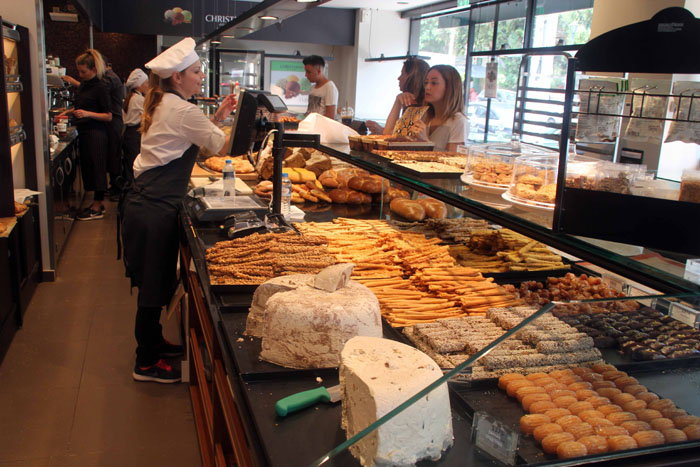
Chora's new Beneti Bakery is an eye-popping food hall showcasing a diverse selection of breads, pastries and prepared sandwiches.
The sun is plunging into the sea as a taxi brings us out to Karfas Beach
for our last dinner in Chios. We select a table at Oasis, a restaurant
operated by Costas Tanainis and his Dutch wife. "Costa is just amazing,"
Alison explains, having met him earlier. "He has set up a delicious
meal service for refugees arriving from the Cesme area." Another
good man, I conclude. But I am not surprised. After all, filoxenia is
ingrained in the Chian soul.
